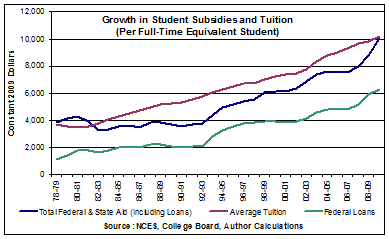
This article from Investors Business Daily is very helpful.
It says:
Bernie Sanders, Hillary Clinton and the rest of the Democratic leadership are constantly complaining that college education costs too much. What they never bother to explain, however, is why.
Two economists set out to do so, and Bernie and company will not like what they found.
Grey Gordon and Aaron Hedlund, economists at Indiana University and the University of Missouri, developed a method to test various explanations for the share rise in tuition costs. Is it state funding cuts? Or the increased wage premium for a college degree? Or is it related to general cost increases in the services industries?
Not exactly. In a working paper published by the National Bureau of Economic Research the economists report that these factors contributed insignificantly to the rapid rise in tuition between 1987 and 2010.
What did account for almost all of it was, ironically enough, the massive explosion in federal aid over the past several decades. Federal aid — in the form of subsidized loans, grants and tax credits — shot up 134% in the past 15 years, according to the College Board. It’s climbed 22% just under President Obama.
Combined with state aid, the government is pouring more than $239 billion a year into programs designed to make college less expensive.
What the authors found is that all this aid money has simply let college administrators spend more and jack up tuition to pay for it, without hurting enrollment. The result is there to see for anyone who visits a college campus these days — gourmet kitchens, luxurious dorms, shiny new administrative buildings, beautiful landscapes, state of the art workout facilities, etc.
The authors call this the “Bennett hypothesis,” after former Education Secretary William Bennett, who wrote in 1987 that “increases in financial aid in recent years have enabled college and universities blithely to raise their tuitions.”
Not only does the increased federal aid lead to higher tuition, the authors found, but it perversely leads to “more debt, and in the absence of higher labor market returns, more loan default inevitably occurs.”
In other words, the Democrats’ plan to provide still greater amounts of federal aid will only make matters worse.
Basically, college administrators know that people are willing to pay X to go to university.
This hypothesis – that it is government subsidies that drive up tuition rates – is supported in the radically leftist New York Times, of all places.
This is by Paul F. Campos, law professor at the radically leftist UC Boulder.
He writes:
[…][T]he astonishing rise in college tuition correlates closely with a huge increase in public subsidies for higher education. If over the past three decades car prices had gone up as fast as tuition, the average new car would cost more than $80,000.
[…]As the baby boomers reached college age, state appropriations to higher education skyrocketed, increasing more than fourfold in today’s dollars, from $11.1 billion in 1960 to $48.2 billion in 1975. By 1980, state funding for higher education had increased a mind-boggling 390 percent in real terms over the previous 20 years. This tsunami of public money did not reduce tuition: quite the contrary.
The more money that is attached to students, the more money universities charge – simple.
But where is the money going? Is it mostly going to research? To the classroom? To hire more and better professors?
No:
Interestingly, increased spending has not been going into the pockets of the typical professor. Salaries of full-time faculty members are, on average, barely higher than they were in 1970. Moreover, while 45 years ago 78 percent of college and university professors were full time, today half of postsecondary faculty members are lower-paid part-time employees, meaning that the average salaries of the people who do the teaching in American higher education are actually quite a bit lower than they were in 1970.
By contrast, a major factor driving increasing costs is the constant expansion of university administration. According to the Department of Education data, administrative positions at colleges and universities grew by 60 percent between 1993 and 2009, which Bloomberg reported was 10 times the rate of growth of tenured faculty positions.
Even more strikingly, an analysis by a professor at California Polytechnic University, Pomona, found that, while the total number of full-time faculty members in the C.S.U. system grew from 11,614 to 12,019 between 1975 and 2008, the total number of administrators grew from 3,800 to 12,183 — a 221 percent increase.
Do you wonder why college is so liberal? It’s because instead of hiring professors to teach you how to do useful work for money, they are hiring useless administrators who just enforce politically correct secular leftism onto the students.
UPDATE: My friend Drew posted this in the comments:
What should young people considering college do? If you’re going to college or trade school, go to a low-cost school. Do a STEM degree or do a trade that pays well. Try to get tuition assistance even if it means going to a less prestigious school. And work at every opportunity you get in the most serious job you can find. Don’t spend your money – save it. Especially don’t spend your money on fun, vacations and alcohol. As soon as you grow up, you’re going to wish you could have it all back.

I love this video:
LikeLike
This is very similar to the fha loan products offered starting in the late 90s with low down payment requirements, which eventually led to the Great Recession.
LikeLike
Yes, sir. It is a student loan bubble, and it is analogous to the Mortgage Lending bubble. Both were caused by the Democrats and their “compassionate” lending standards.
LikeLike